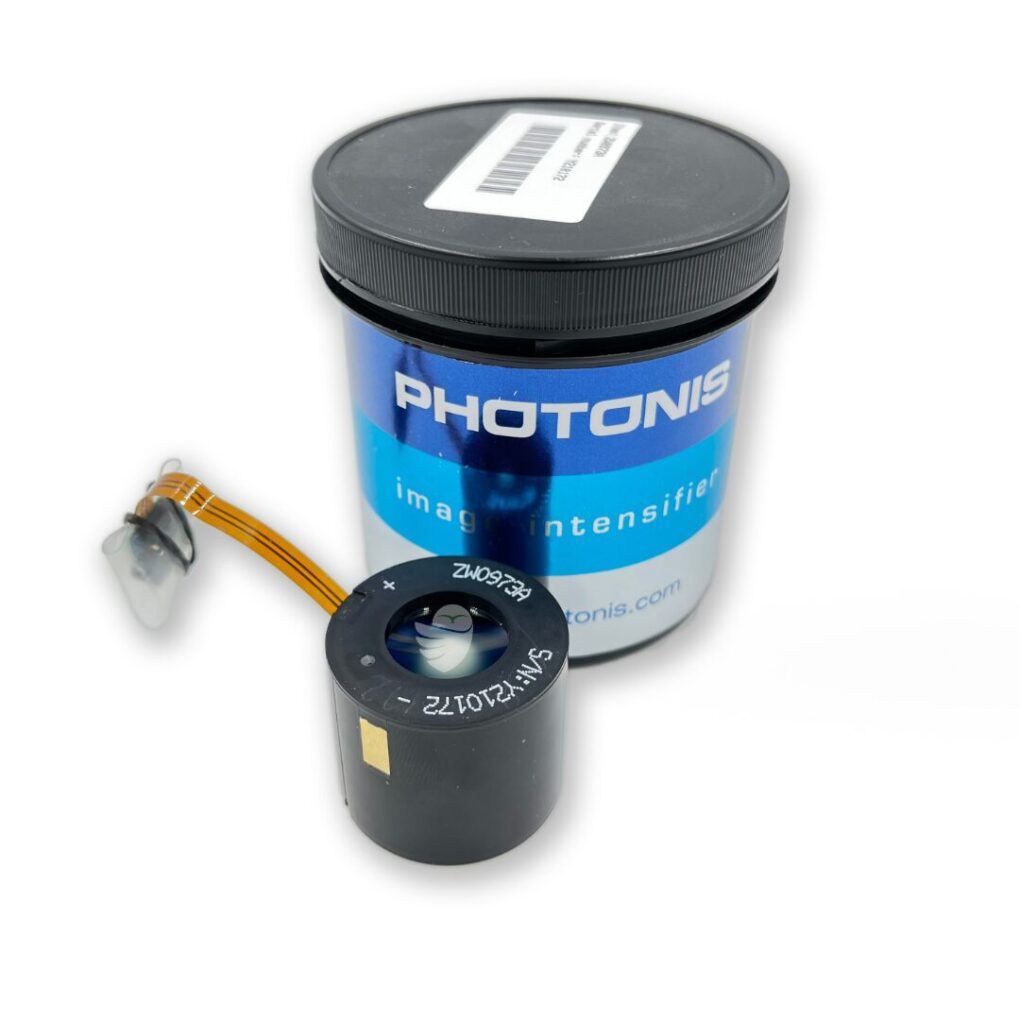Choosing between white phosphor vs green night vision devices can be challenging. This article will help you understand the benefits and drawbacks of each, so you can decide which one is right for you.
Understanding Night Vision Technology
Devices designed for night vision have significantly advanced, incorporating technology that boosts optoelectronic image enhancement to amplify available visible light. This process harnesses optical lenses alongside electronic vacuum tubes to heighten the faintest of lights, which enables a clear image even in pitch-black conditions. Essential in realms such as military operations, security enforcement, and nocturnal outdoor activities, this technology is crucial for providing visibility where natural illumination falls short.
Integral to these devices is the screen coated with phosphor. When it interacts with electrons through bombardment, it emits a luminous glow that typically appears green—a hue easily registered by our eyesight—thus allowing individuals to maneuver and discern objects amidst dim lighting scenarios effectively.
In recent years, there have been notable strides within the night vision community concerning emerging technologies that broaden operational capacity. Becoming well-acquainted with both the workings and applications of this technology aids in making informed choices when picking out an appropriate night vision device tailored for specific needs.
The Role of Phosphor Screens in Night Vision
Night vision technology heavily relies on the often overlooked component of phosphor screens. These are essentially layers placed upon glass that turn amplified electron streams into visible light, thereby illuminating darker environments well beyond human-eye capabilities.
These vital components come in various colors like red, blue, and green. But for night vision purposes, it’s the white and green phosphors that prevail. The traditional use of green phosphor (P43) has defined the classic image of night vision with its characteristic emerald hue. On the other hand, white phosphor (P45) renders a monochromatic whitish image which provides an alternate visual representation compared to when using both green and white.
Deciding between utilizing a device equipped with either a green or white screen is not solely based on aesthetic preference but involves practical considerations as well since each offers unique benefits along with certain limitations. Understanding these nuances helps ensure you select a night vision solution best suited to your specific needs.
Green Phosphor Night Vision Devices
Night vision devices that utilize green phosphor have proven their efficiency in numerous situations where lighting is minimal. Due to the heightened sensitivity of the human eye to green light, it manifests as more luminous and distinct under conditions with scarce illumination. This attribute guarantees that night vision apparatus employing green are exceptionally useful when tasks necessitate elevated contrast and sharp visibility.
Such equipment has maintained a reputation for reliability over an extensive period, having been employed consistently for over forty years across diverse domains such as monitoring construction areas to conducting emergency searches. The long-standing usage and widespread acceptance of these devices underscore their dependability and efficacy in fulfilling various needs.
Advantages of Green Phosphor
The inherent sensitivity of the human eye to green light is a key benefit when using green phosphor in night vision devices. This heightened sensitivity translates into brighter, more distinct images under low-light conditions, providing vital enhanced contrast essential for activities that require precise and clear visuals.
Screens with green phosphor are known for their good contrast and superior clarity, which facilitates prolonged use without causing significant eye strain. The characteristic green hue minimizes discomfort, allowing individuals to employ these devices comfortably over longer durations.
The proven dependability of green phosphor technology through years of application cements its status as a reliable option across numerous standard uses. Its established history assures users’ confidence in this technology for an array of purposes including military maneuvers and nocturnal wildlife observations.
Disadvantages of Green Phosphor
Night vision technology that utilizes green phosphor has its advantages, but it’s not without certain disadvantages. Prolonged usage of night vision devices emitting green light can cause eye fatigue even though this hue is easier on the eyes than other colors. This could pose a considerable problem during extensive use in lengthy missions.
These phosphor night vision devices may necessitate more frequent battery replacements, which adds to both logistical complexities and operational expenses. While they don’t render the technology impractical, these drawbacks should be taken into account by those considering an investment in night vision equipment.
White Phosphor Night Vision Devices
Night vision devices equipped with white phosphor technology represent an advancement that has risen to prominence over the last ten years. Utilizing white phosphor screens, these units provide better contrast sensitivity and superior identification of objects than their traditional counterparts featuring green phosphor tubes. The increased performance conferred by white phosphor makes it indispensable in critical situations where discerning fine details is crucial.
White phosphor night vision offers a substantial benefit through its delivery of more authentic nighttime imagery, mirroring natural grayscale scenes. This realistic portrayal not only amplifies perceptual accuracy but also mitigates eye fatigue, making such devices particularly suitable for activities like vehicular navigation and close-range marksmanship during the night hours.
Advantages of White Phosphor
Night vision devices utilizing white phosphor yield an image of superior quality that is crisper and more intricate. This enhanced clarity becomes crucial when the rapid and precise identification of objects is necessary, as it can be a pivotal factor in certain situations. These devices aid in perceiving depth with greater ease by streamlining the assessment process for judging distances and understanding spatial connections.
The grayscale visuals produced by white phosphor technology resemble those seen naturally, thereby minimizing eye strain during prolonged usage. Such a feature proves advantageous in scenarios demanding sustained attention over extensive durations.
To green phosphor night vision technology, white phosphor offers numerous improvements including heightened clarity and diminished eye fatigue. These advancements position white phosphor night vision gadgets as prime choices across various contexts ranging from military missions to leisure activities.
Disadvantages of White Phosphor
Night vision devices featuring white phosphor technology tend to come with a steeper price tag than their green phosphor counterparts. The higher cost associated with white phosphor night vision is an important consideration for individuals and entities that need to manage expenses carefully, influencing the decision-making process when selecting between these two options.
Such devices are known for their elevated power consumption rates leading to reduced active usage times without recharging or replacing batteries. This increase in energy requirements might necessitate extra gear or power solutions, adding complexity to logistical planning during use at night.
There can be an adaptation period required for users transitioning to displays based on white phosphor. Although some may find it initially challenging to get accustomed to this new visual environment, it is often a temporary setback that diminishes as familiarity grows through sustained application of the technology.
Comparing Green and White Phosphor Night Vision
In the realm of phosphor night vision devices, one must weigh various considerations when comparing those with green versus white phosphor. White phosphor technology enables crisper and more intricate visuals which are pivotal in situations where stakes run high. They render scenes in a monochrome palette that tends to be simpler for users to process and comprehend.
Conversely, the industry has favored green phosphor-based night vision solutions for over four decades owing to their dependability. The enhanced sensitivity of human eyes to green light means that these devices can achieve superior contrast and finer details during times when illumination is minimal. Objects might seem less realistic under this type of lighting condition, which could complicate recognition tasks.
Power consumption also plays a significant role. White phosphor variants may necessitate changes in batteries more frequently due to their greater energy demands. This increased power usage can impinge on operational effectiveness across extended durations or assignments out in the field. Choosing between utilizing either green or white phosphor hinges on an individual’s particular needs and limitations related to use cases involving nighttime visibility technology.
Practical Considerations for Choosing Night Vision Devices
Selecting an appropriate night vision device goes beyond the choice between green and white phosphor technologies. The decision must take into account practical aspects such as specific mission needs, financial limitations, and user familiarity with the equipment. It is vital to consider these elements carefully to make a well-informed selection.
When considering costs, it’s important to note that devices equipped with green phosphor typically come at a more economical price point than those featuring white phosphor technology. Nevertheless, while budgetary considerations are key, they should be weighed against the particular requirements of your operation and the advantages in image clarity offered by white phosphor devices.
Lastly, factors like user experience and comfort with certain types of technology cannot be overlooked. Users who have relied on green phosphorous-based night vision may prefer its time-tested dependability. On the flip side though. Providing superior quality images that can decidedly enhance operational effectiveness under particular circumstances are unmistakably valuable attributes associated with recent advancements represented therein.
Use Cases for Green Phosphor
Night vision devices that employ green phosphor are highly efficient for regular tasks where significant contrast is essential, and the environment is relatively mild. They excel in routine activities such as monitoring construction sites or following objects in emergency scenarios, making these green night vision tools particularly suitable.
The traditional dependability of green phosphor has led to its common selection for military assignments when supreme image clarity isn’t a critical requirement. Their suitability extends across various uses, from recreational outdoor pursuits to typical military engagements due to their versatility.
Use Cases for White Phosphor
Night vision devices that utilize white phosphor technology are paramount in critical situations, especially within military and law enforcement fields where precision image clarity and depth perception play crucial roles. Such white phosphor night vision equipment is adept at improving visibility under the dim conditions of rural landscapes, proving beneficial for search and rescue operations as well as tactical maneuvers.
Incorporating white phosphor into these devices substantially boosts the likelihood of identifying individuals needing help during search and rescue missions due to its enhanced detail. White phosphor night vision technology presents clear benefits in a multitude of circumstances by elevating both image definition and situational awareness across different sectors.
Steele Industries Inc.: Leading Provider of Night Vision Equipment
Headquartered in Florida, Steele Industries Inc. is a distinguished provider renowned for its superior night vision solutions. Committed to delivering unmatched performance and value, along with the best available inventory within the industry, their mission aligns with ensuring excellence and customer delight. The company owes its strong foundational values to Dominick Steele, who serves as both CEO and Founder.
With certifications like ISO 9001:2015 and ISO 14644-1 under its belt, Steele Industries Inc.’s product lineup adheres to strict quality benchmarks. Their offerings encompass a spectrum of phosphor night vision goggles that utilize both green and white phosphors, designed to fit various preferences as well as financial considerations.
Steele Industries Inc.’s commitment extends beyond providing competitive prices. They also present promotional deals and payment plans which enhance their appeal among individual buyers and institutional clients alike. This dedication not only fosters consumer trust but has also established them as pioneers in setting new precedents throughout the global night vision community.


